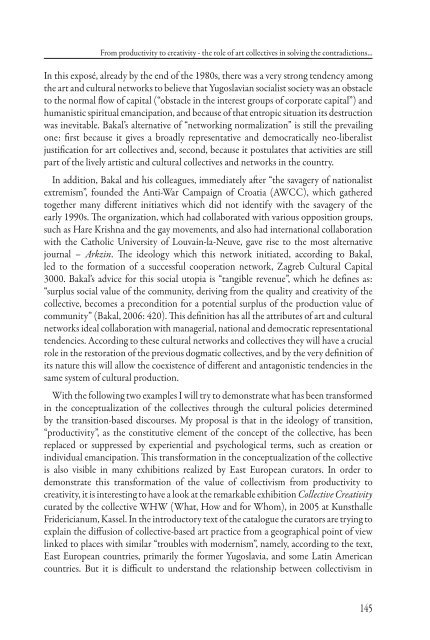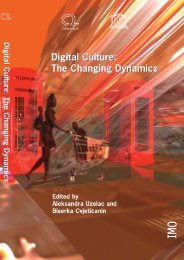free download in pdf format - Culturelink Network
free download in pdf format - Culturelink Network
free download in pdf format - Culturelink Network
You also want an ePaper? Increase the reach of your titles
YUMPU automatically turns print PDFs into web optimized ePapers that Google loves.
From productivity to creativity - the role of art collectives <strong>in</strong> solv<strong>in</strong>g the contradictions...<br />
In this exposé, already by the end of the 1980s, there was a very strong tendency among<br />
the art and cultural networks to believe that Yugoslavian socialist society was an obstacle<br />
to the normal fl ow of capital (“obstacle <strong>in</strong> the <strong>in</strong>terest groups of corporate capital”) and<br />
humanistic spiritual emancipation, and because of that entropic situation its destruction<br />
was <strong>in</strong>evitable. Bakal’s alternative of “network<strong>in</strong>g normalization” is still the prevail<strong>in</strong>g<br />
one: fi rst because it gives a broadly representative and democratically neo-liberalist<br />
justifi cation for art collectives and, second, because it postulates that activities are still<br />
part of the lively artistic and cultural collectives and networks <strong>in</strong> the country.<br />
In addition, Bakal and his colleagues, immediately aft er “the savagery of nationalist<br />
extremism”, founded the Anti-War Campaign of Croatia (AWCC), which gathered<br />
together many diff erent <strong>in</strong>itiatives which did not identify with the savagery of the<br />
early 1990s. Th e organization, which had collaborated with various opposition groups,<br />
such as Hare Krishna and the gay movements, and also had <strong>in</strong>ternational collaboration<br />
with the Catholic University of Louva<strong>in</strong>-la-Neuve, gave rise to the most alternative<br />
journal – Arkz<strong>in</strong>. Th e ideology which this network <strong>in</strong>itiated, accord<strong>in</strong>g to Bakal,<br />
led to the <strong>format</strong>ion of a successful cooperation network, Zagreb Cultural Capital<br />
3000. Bakal’s advice for this social utopia is “tangible revenue”, which he defi nes as:<br />
“surplus social value of the community, deriv<strong>in</strong>g from the quality and creativity of the<br />
collective, becomes a precondition for a potential surplus of the production value of<br />
community” (Bakal, 2006: 420). Th is defi nition has all the attributes of art and cultural<br />
networks ideal collaboration with managerial, national and democratic representational<br />
tendencies. Accord<strong>in</strong>g to these cultural networks and collectives they will have a crucial<br />
role <strong>in</strong> the restoration of the previous dogmatic collectives, and by the very defi nition of<br />
its nature this will allow the coexistence of diff erent and antagonistic tendencies <strong>in</strong> the<br />
same system of cultural production.<br />
With the follow<strong>in</strong>g two examples I will try to demonstrate what has been transformed<br />
<strong>in</strong> the conceptualization of the collectives through the cultural policies determ<strong>in</strong>ed<br />
by the transition-based discourses. My proposal is that <strong>in</strong> the ideology of transition,<br />
“productivity”, as the constitutive element of the concept of the collective, has been<br />
replaced or suppressed by experiential and psychological terms, such as creation or<br />
<strong>in</strong>dividual emancipation. Th is trans<strong>format</strong>ion <strong>in</strong> the conceptualization of the collective<br />
is also visible <strong>in</strong> many exhibitions realized by East European curators. In order to<br />
demonstrate this trans<strong>format</strong>ion of the value of collectivism from productivity to<br />
creativity, it is <strong>in</strong>terest<strong>in</strong>g to have a look at the remarkable exhibition Collective Creativity<br />
curated by the collective WHW (What, How and for Whom), <strong>in</strong> 2005 at Kunsthalle<br />
Fridericianum, Kassel. In the <strong>in</strong>troductory text of the catalogue the curators are try<strong>in</strong>g to<br />
expla<strong>in</strong> the diff usion of collective-based art practice from a geographical po<strong>in</strong>t of view<br />
l<strong>in</strong>ked to places with similar “troubles with modernism”, namely, accord<strong>in</strong>g to the text,<br />
East European countries, primarily the former Yugoslavia, and some Lat<strong>in</strong> American<br />
countries. But it is diffi cult to understand the relationship between collectivism <strong>in</strong><br />
145



